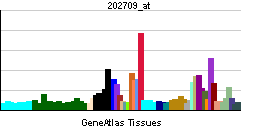FMOD (gene)
Jump to navigation
Jump to search
| Fibromodulin | |||||||||||
|---|---|---|---|---|---|---|---|---|---|---|---|
| Identifiers | |||||||||||
| Symbols | FMOD ; SLRR2E | ||||||||||
| External IDs | Template:OMIM5 Template:MGI HomoloGene: 1530 | ||||||||||
| |||||||||||
| RNA expression pattern | |||||||||||
 | |||||||||||
| More reference expression data | |||||||||||
| Orthologs | |||||||||||
| Template:GNF Ortholog box | |||||||||||
| Species | Human | Mouse | |||||||||
| Entrez | n/a | n/a | |||||||||
| Ensembl | n/a | n/a | |||||||||
| UniProt | n/a | n/a | |||||||||
| RefSeq (mRNA) | n/a | n/a | |||||||||
| RefSeq (protein) | n/a | n/a | |||||||||
| Location (UCSC) | n/a | n/a | |||||||||
| PubMed search | n/a | n/a | |||||||||
Fibromodulin, also known as FMOD, is a human gene.[1]
Fibromodulin is a member of a family of small interstitial proteoglycans, containing a central region composed of leucine-rich repeats with 4 keratan sulfate chains flanked by disulfide-bonded terminal domains. It may participate in the assembly of the extracellular matrix as it interacts with type I and type II collagen fibrils and inhibits fibrillogenesis in vitro. It may also regulate TGF-beta activities by sequestering TGF-beta into the extracellular matrix.[1]
References
Further reading
- Roughley PJ, Lee ER (1994). "Cartilage proteoglycans: structure and potential functions". Microsc. Res. Tech. 28 (5): 385–97. doi:10.1002/jemt.1070280505. PMID 7919526.
- Sztrolovics R, Chen XN, Grover J; et al. (1995). "Localization of the human fibromodulin gene (FMOD) to chromosome 1q32 and completion of the cDNA sequence". Genomics. 23 (3): 715–7. doi:10.1006/geno.1994.1567. PMID 7851907.
- Hildebrand A, Romarís M, Rasmussen LM; et al. (1994). "Interaction of the small interstitial proteoglycans biglycan, decorin and fibromodulin with transforming growth factor beta". Biochem. J. 302 ( Pt 2): 527–34. PMID 8093006.
- Antonsson P, Heinegård D, Oldberg A (1993). "Structure and deduced amino acid sequence of the human fibromodulin gene". Biochim. Biophys. Acta. 1174 (2): 204–6. PMID 8357838.
- Bonaldo MF, Lennon G, Soares MB (1997). "Normalization and subtraction: two approaches to facilitate gene discovery". Genome Res. 6 (9): 791–806. PMID 8889548.
- Westergren-Thorsson G, Norman M, Björnsson S; et al. (1998). "Differential expressions of mRNA for proteoglycans, collagens and transforming growth factor-beta in the human cervix during pregnancy and involution". Biochim. Biophys. Acta. 1406 (2): 203–13. PMID 9573366.
- Font B, Eichenberger D, Goldschmidt D; et al. (1998). "Structural requirements for fibromodulin binding to collagen and the control of type I collagen fibrillogenesis--critical roles for disulphide bonding and the C-terminal region". Eur. J. Biochem. 254 (3): 580–7. PMID 9688269.
- Schaefer L, Gröne HJ, Raslik I; et al. (2000). "Small proteoglycans of normal adult human kidney: distinct expression patterns of decorin, biglycan, fibromodulin, and lumican". Kidney Int. 58 (4): 1557–68. doi:10.1046/j.1523-1755.2000.00317.x. PMID 11012890.
- Gori F, Schipani E, Demay MB (2001). "Fibromodulin is expressed by both chondrocytes and osteoblasts during fetal bone development". J. Cell. Biochem. 82 (1): 46–57. PMID 11400162.
- Strausberg RL, Feingold EA, Grouse LH; et al. (2003). "Generation and initial analysis of more than 15,000 full-length human and mouse cDNA sequences". Proc. Natl. Acad. Sci. U.S.A. 99 (26): 16899–903. doi:10.1073/pnas.242603899. PMID 12477932.
- Ota T, Suzuki Y, Nishikawa T; et al. (2004). "Complete sequencing and characterization of 21,243 full-length human cDNAs". Nat. Genet. 36 (1): 40–5. doi:10.1038/ng1285. PMID 14702039.
- Mayr C, Bund D, Schlee M; et al. (2005). "Fibromodulin as a novel tumor-associated antigen (TAA) in chronic lymphocytic leukemia (CLL), which allows expansion of specific CD8+ autologous T lymphocytes". Blood. 105 (4): 1566–73. doi:10.1182/blood-2004-04-1233. PMID 15471955.
- Mikaelsson E, Danesh-Manesh AH, Lüppert A; et al. (2005). "Fibromodulin, an extracellular matrix protein: characterization of its unique gene and protein expression in B-cell chronic lymphocytic leukemia and mantle cell lymphoma". Blood. 105 (12): 4828–35. doi:10.1182/blood-2004-10-3941. PMID 15741214.
- Sjöberg A, Onnerfjord P, Mörgelin M; et al. (2005). "The extracellular matrix and inflammation: fibromodulin activates the classical pathway of complement by directly binding C1q". J. Biol. Chem. 280 (37): 32301–8. doi:10.1074/jbc.M504828200. PMID 16046396.
- Rual JF, Venkatesan K, Hao T; et al. (2005). "Towards a proteome-scale map of the human protein-protein interaction network". Nature. 437 (7062): 1173–8. doi:10.1038/nature04209. PMID 16189514.
- Sjöberg AP, Trouw LA, Clark SJ; et al. (2007). "The factor H variant associated with age-related macular degeneration (His-384) and the non-disease-associated form bind differentially to C-reactive protein, fibromodulin, DNA, and necrotic cells". J. Biol. Chem. 282 (15): 10894–900. doi:10.1074/jbc.M610256200. PMID 17293598.
- Kalamajski S, Oldberg A (2007). "Fibromodulin binds collagen type I via Glu-353 and Lys-355 in leucine-rich repeat 11". J. Biol. Chem. 282 (37): 26740–5. doi:10.1074/jbc.M704026200. PMID 17623650.
| This protein-related article is a stub. You can help Wikipedia by expanding it. |